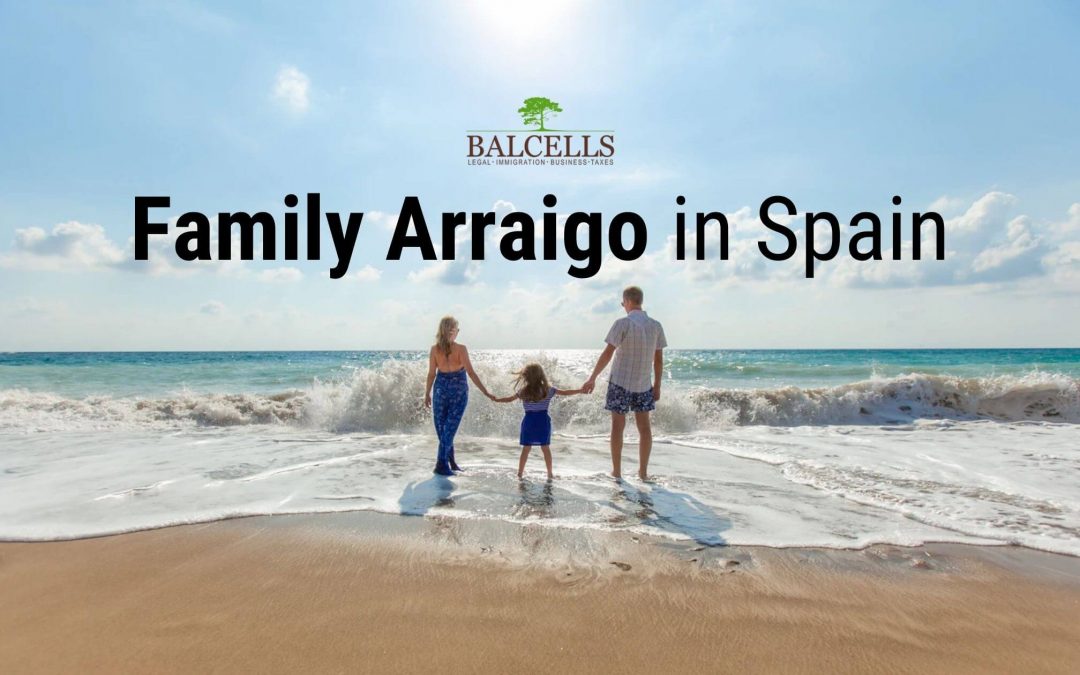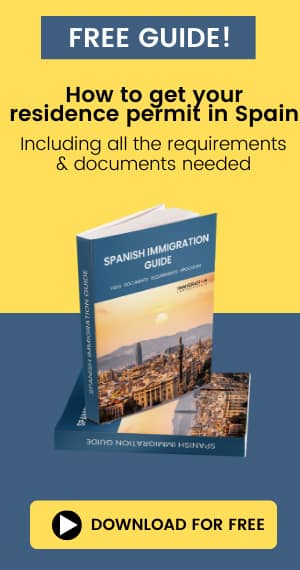All those foreigners who can demonstrate a link with a Spanish citizen have it now very easy to start living legally in Spain. Although until recently we only found the family arraigo process for specific cases like being the parent of a Spanish child, today there are many more cases that will allow you to obtain this 5-year residency card. In this article, you will discover everything you must know about the family arraigo residency, including all major updates and new advantages of this permit.
What is the family arraigo residency?
The arraigo familiar or family arraigo is a residence authorization due to exceptional circumstances that grants the possibility to live and work in Spain for 5 years (instead of just 5 as happened before) to those non-EU foreigners who can demonstrate a link with a Spanish citizen of any kind.
That is, the family arraigo residency is nowadays destined not just to those foreigners with a Spanish child or parent, but to many others as well.
However, this authorization will be for 1 year (extendable or modifiable to a residence and work permit) in the case of requesting the “arraigo” as a child of a father or mother who were originally Spanish.
When it comes to requirements, the application process is quite simple.
And if we also take into account that this authorization must be obtained while the foreigner is in under irregular situation (it is not necessary to request a visa to enter Spain), it turns out to be one of the most favorable paths to residency for many.
In addition as being a 5-year card, another of its great advantages is that it allows you to work in Spanish territory both as a freelancer (i.e., registering yourself as a self-employed worker and offering your services as an independent professional) and as an employee of a Spanish company.
Together with the two other types of arraigo (social, labor, and study), the family arraigo is regulated by Article 123 (and more specifically Article 124) of the Spanish general immigration regulation.
There are different ways to obtain this residence authorization (as we will now see), but they all have something in common: in order to apply for family arraigo it is necessary to be a family member of a Spanish or EU citizen.
Let’s see how that is actually translated.
Before continuing, however, we must make an important clarification.
Once the new reform of the Spanish Immigration regulation is published (probably at the end of 2024), family members of Spanish citizens will apply for residency through a new authorization. If you want to know more, here you can access an article in which we talk about this great novelty, where you can find all its advantages and requirements in detail.
How to obtain the family arraigo: all scenarios
Since the last Spanish immigration law update, additional family members have been incorporated into the general regime, many of those who were previously under the EU one.
That is to say, in many cases in which the relatives of the Spanish citizen had to apply for an EU family card in order to start living in Spanish territory, now they can do it through the family arraigo process.
This means that nowadays many more foreigners can benefit from family roots, something that offers great advantages for them (compared to applying for a EU family member card).
Below we analyze the complete list of foreigners who can apply for this residency authorization, taking into account that what they all have in common is a link with a Spanish citizen as a key requirement.
Family arraigo through a Spanish child
The first way to obtain this type of arraigo is to be the parent of a Spanish child who is under 18 years old.
Is it necessary to be living with the minor?
No, since there are two different cases.
In the first place, we find the case in which the father or mother lives with the child of Spanish nationality.
But, in addition, it is also possible to request this arraigo if you do not live with the child, but are up to date with all your parental obligations.
That is to say, you are up to date with child support payments and you comply with the visitation regime.
Family arraigo through having an EU child
On the other hand, if you are a foreigner but your child is Italian, German, French or from any country of the European Union, you could also apply for your family roots.
But, again, here we can find two possible scenarios:
- If you have sufficient economic means, instead of going through the arraigo path you will apply for the community card (a residency card for 5 years)
- If you do not have sufficient means and you do not live with your son or daughter, then you will have to apply for the arraigo familiar following the procedure described in this article
Family arraigo through being the child of a Spanish citizen of origin
On the other hand, there is the case in which you are the child of a Spanish citizen of origin; that is, you have either a Spanish father or mother.
Here you will simply have to provide your birth certificate to prove the family relationship and that of your father or mother to verify that they are Spaniards by origin, and the family arraigo will be granted to you.
When it comes to the application, your age here is irrelevant, as the only requirement here is to be able to prove the kindship bond.
Family arraigo through marriage or accredited partnership
Here we find one of the new groups that now can obtain the residence through the family arraigo (instead of doing it through the EU card).
Both the spouse (person united in marriage) and the accredited civil partner of the Spanish citizen can also apply for this authorization.
It is important to take into account what exactly the term accredited partner refers to, since it is new in the Spanish immigration law and is generating a lot of confusion.
In this sense, the accredited partner refers only to registered partners (civil union). The rest of the cases of couples that are not registered (stable couples), will continue applying for the community card.
Ascendants of the Spanish citizen or of her partner
Both the parents of the Spanish citizen and the parents of the spouse or accredited partner may also request this authorization.
Here the age plays a fundamental role, since if these ascendants are under 65 years old, it will be necessary that they live under the charge of the Spanish national and that they depend economically on him or her.
Children or descendants
On the other hand, children under 21 of both the Spaniard and his or her partner also are within the groups of foreigners that can complete the application process.
Again, if they are over 21 years of age, it will be necessary to demonstrate that they live under the care of their parents.
Guardian of a minor or support person
Finally, we find 2 cases that, although unusual, are brand new within the family arraigo regulation.
Both the legal guardian or tutor of Spanish child (who is not his or her parent, but his or her representative for legal purposes) and a foreigner who provides support on a daily basis to a Spanish person with a disability can also apply for family roots, even if they do not have a blood relationship with him or her.
In the first case, the guardian must also be in charge of the minor’s parental obligations; and in the second case, the supporting person must live with the Spanish citizen.
Do you have any questions so far? If that is the case, ask us anything:
Requirements for arraigo familiar
In addition to being in any one of the abovementioned cases, there are a series of requirements that must also be met in order to successfully apply for this residence authorization for exceptional circumstances:
- You must not have criminal or police records, both in Spain an in any other country where you have lived for the past 5 years
- You can’t have the entry to Spain prohibited
- Demonstrate the kinship bond with the Spanish national
- You can’t be a citizen of any EU country
- You must be in Spain at the moment of your application (since you cannot apply for this residency from your country of origin), even if you are in an irregular situation
Bear in mind that unlike social arraigo, in this case it is not necessary to demonstrate any previous period of time lived in Spain; therefore, you could apply for this authorization after just 1 or 2 weeks in the country.
Another advantage of this permit is that it does NOT require financial means (another big difference in relation to before when it was requested through the community card).
That is to say, it will not be necessary to provide a work contract or to demonstrate the possession of sufficient economic funds in your bank account.
Documents you will have to submit
As this is a simple procedure, there are not a large number of documents that you will have to submit together with your application.
But which are exactly those documents?
- Application form EX-10
- Criminal record certificate from your country of origin
- Your passport (including a copy)
- The birth certificate of your Spanish or EU child (if you find yourself under this category)
- If you are the child of a Spanish citizen by origin your birth certificate to prove the kinship bond
- In the case of applying through marriage or civil partnership, documentation proving the registration of the union
- The birth certificate of your father or mother (whichever was originally Spanish)
- Document of guardianship of the minor in the case of being his legal representative
- Birth certificate of the descendant in the case of requesting the root as father or mother of a Spaniard
- Documentation accrediting the disability of the Spanish citizen, or the need for support measures for the exercise of their legal capacity in the case of the last case we have seen, in addition to the Spanish citizen’s ID card (DNI)
- Joint census or citi hall registration (“empadronamiento”) with the non-EU citizen
It is important to mention that any foreign document must be translated into Spanish and legalized/apostilled. This will especially apply in the case of birth certificates.
Application procedure step-by-step
The first thing to keep in mind is that the process must be initiated from Spain, and never from abroad.
Therefore, the applicant must have traveled to Spanish territory before submitting his/her file.
Once you have all the documents ready, you must prepare and submit them to the Immigration Office corresponding to your usual residence.
Nowadays, this application is carried out online.
This is undoubtedly great news, as the process will go much faster and you will get your resolution in less time. You can submit all the paperwork online using your digital certificate through the Mercurio platform.
The exact resolution time will vary depending on the immigration office where you have initiated the procedure (those in big cities will be slower as they have much more applications to analyze).
However, this is a procedure that does not usually take very long, so you could get the resolution in just a few weeks.
Legally, the administration has a total of 3 months to issue a resolution. If you have not received a response after this time, your file will be considered denied due to negative administrative silence.
Once you get your favorable resolution, you must then apply for your physical card (TIE).
To do so, you will need to go back to the immigration office with your passport, the positive resolution, the EX-17 form, the 790-012 fee paid, and 3 passport photographs.
What if my application gets rejected?
It is unusual for your application to get rejected, because if you carefully read this article and make sure you meet all the requirements you should not have any problems.
However, it is possible that for some reason your application is rejected.
In that case, you will have two different options:
- File an administrative appeal
- Go directly to court by filing a contentious-administrative appeal.
Undertaking an appeal, whatever type it may be, can be a tedious and complicated task.
What is the best option then?
You will choose one route or the other depending on your particular situation, although in many cases it may be advisable not to use either of these two paths in order to avoid wasting time and money.
That is why our recommendation is that you contact our lawyers so that we can assess your situation.
We will analyze if it is really necessary to initiate an appeal (if so, we will see what type), or if it would be advisable to opt for other alternative ways to end up getting the residence in Spain under an easier option.
Renewal process
Once the total duration of this card is over (which we have seen is 5 or 1 years), the time to renew will arrive.
How does it work?
If the card is for 5 years, you will have it very easy: you can apply for a long-term or permanent card.
But if you have obtained a 1-year card because you have applied for arraigo as a child of a father or mother who was originally Spanish, you will not be able to renew. Technically speaking, what you will be doing is a modification: modifying to a regular residence permit.
In this case, the renewal has a number of fairly strict requirements (especially labor ones) that pose difficulties in many cases.
Then, in order to renew you will have three options available. You will be able to modify to:
- Non-profit residency, in case you have sufficient financial means and have not worked (nor want to do so in the future)
- Self-employed work permit (“por cuenta propia”), if you have been providing your services as an independent professional
- A work permit as an employee (“por cuenta ajena”), if you can prove that you have worked for a minimum period of time in the country during your family arraigo year
If you do not meet the requirements for any of these three options, you may be able to make an extension of your family arraigo (equivalent to a second application).
If you need legal assistance with your application, our lawyers are at your complete disposal. We will manage everything on your behalf so you just need to sign!
Book a consultation with one of our lawyers and solve all your doubts:



